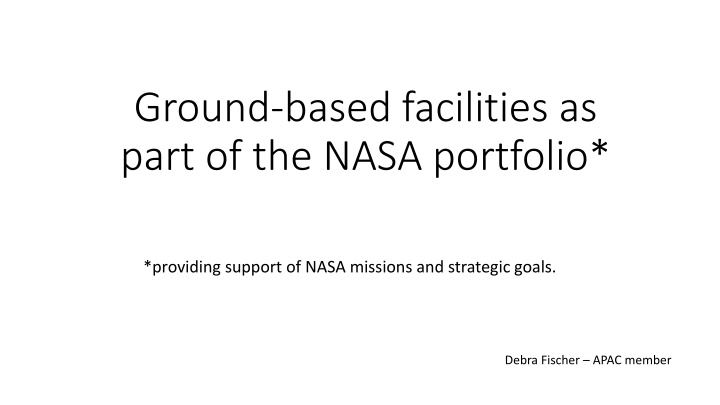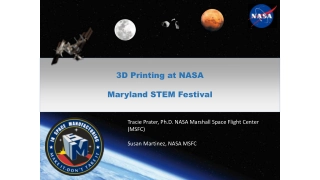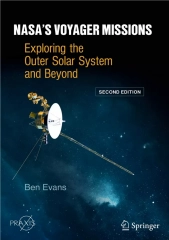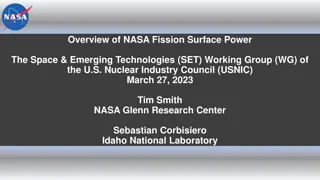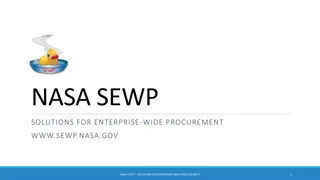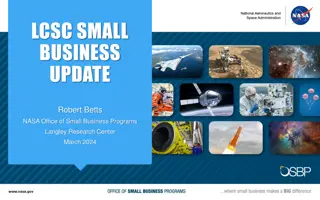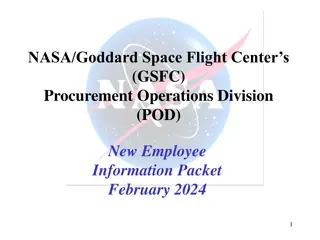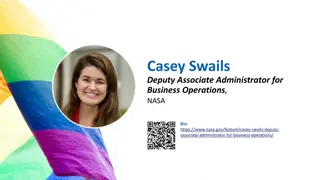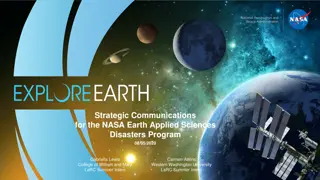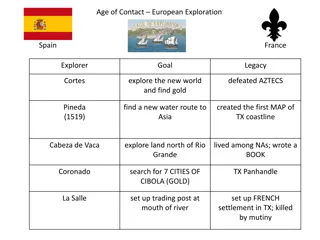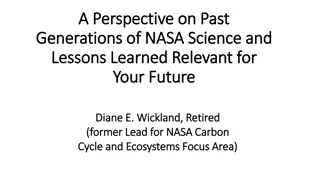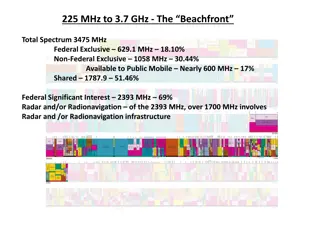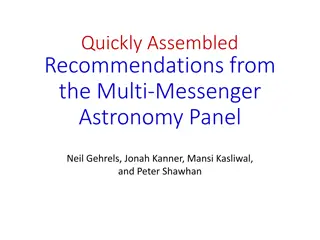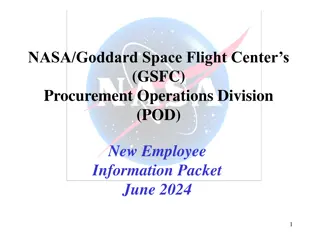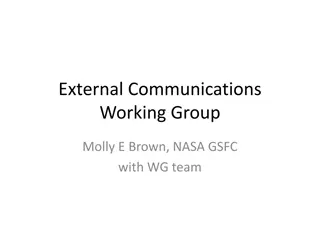Strategic Ground-Based Support for NASA Missions
Discussing NASA's strategic need for ground-based facilities supporting missions, underscored by gaps affecting future projects like TESS, WFIRST, and JWST. Emphasizes the importance of higher precision in RV measurements for better planetary understanding and the need for a system engineering approach. Calls for a strategic pathway in technology development for ground-based observations to meet long-term NASA vision.
Download Presentation

Please find below an Image/Link to download the presentation.
The content on the website is provided AS IS for your information and personal use only. It may not be sold, licensed, or shared on other websites without obtaining consent from the author.If you encounter any issues during the download, it is possible that the publisher has removed the file from their server.
You are allowed to download the files provided on this website for personal or commercial use, subject to the condition that they are used lawfully. All files are the property of their respective owners.
The content on the website is provided AS IS for your information and personal use only. It may not be sold, licensed, or shared on other websites without obtaining consent from the author.
E N D
Presentation Transcript
Ground-based facilities as part of the NASA portfolio* *providing support of NASA missions and strategic goals. Debra Fischer APAC member
At the NRC OIR committee Optimizing the OIR system in the era of LSST: Paul Hertz presentation (7/31/14) discussed NASA strategic needs for ground-based optical and IR astronomy. From his presentation: NASA use is based on: strategic needs for development of missions (technology testbeds and instrumentation) Interpretation and understanding of space data Exploitation of space and data archives NASA facility investments: IRTF (100%) Keck (1/6th investment): 40% of time goes explicitly to mission support and the remaining time is for proposals with importance to NASA strategic goals. LBTI UKIRT Arecibo NEO searches, DSN WIYN + NEID spectrograph (40%): NASA is paying for the spectrograph (plus funds for data analysis by investigators?), NSF provides facility support for telescope time
NASA HQ understands the importance of procuring strategic ground-based observations in support of missions. However, there are real gaps with impact on future missions: TESS will need AO and higher precision RVs and this is particularly acute in the southern hemisphere. WFIRST exoplanets will need RVs, perhaps wide field imaging to obtain optical colors to go with WFIRST NIR colors (LSST helps). WFIRST would also benefit from a network of ground-based microlensing campaigns. JWST needs masses and densities for well-characterized planets. There are some big advantages for simultaneous ground + JWST data. In short: the current US community access to PRV spectrographs is inadequate for supporting the long-term vision of NASA. May require a *system* of ground- based support.
There are two issues: access and technology development. Imagine the Kepler yield if PRV precision had been 0.2 m/s instead of 2 m/s. Revealed multi-planetary architecture and sibling non-transiting planets. Actual mass measurements instead of limits; true densities. Shapes of orbits evidence for evolution of planetary systems. Getting higher RV precision is a solvable problem (like extracting the CMB signal). But it requires a system engineering approach. NASA has been investing in procurement of some strategic ground-based observations, but there is not a strategic path for needed technology development.
Whose role is it to provide advice about ground-based strategic support of space missions? If the team working on Mission X notes a need for ground-based data will that project be required to carry the cost for that work? If the mission team notes a need for ground-based data (especially precursor work), will there be a risk of delaying the mission until the required data are in hand? Folks working on ground-based projects may have a conflict of interest. It is possible that a $100M investment in a network of ground based facilities is needed for follow-up. This should NOT be done unless the RV precision is improved.
If the APAC thinks this is an important question to consider, what information do we need for a more complete discussion? Are existing NASA investments in ground based facilities sufficient for the next wave of missions (TESS, JWST, WFIRST, etc)? These missions represent major tax-payer investments, but much of the work requires additional supporting data. To what extent do we risk having other countries scoop key science because they have the necessary southern hemisphere ground-based facilities? (Do we care?) Is there the right balance of instruments, with the right wavelength coverage on the right suite of telescopes? (e.g., need WF imaging to get optical colors to go with WFIRST NIR colors) Are the portfolio facilities sufficiently supported for ongoing maintenance and modernization?
If the APAC thinks this is an important question to consider, what information do we need for a more complete discussion? What is the sensitivity gap between space and ground-based facilities? (JWST will reach 30th magnitude in some fields) Is there adequate geographical coverage (southern hemisphere)? Consider the role of private as well as national facilities? Is there sufficient support for the data archives? (~15% of Keck papers acknowledge the Keck archive)
Supplementary Slides (provided on request by Chas Beichman)
NASA Strategic Key Science Projects 2005B: TPF Cochran (McDonald Obs) 2007 - 2008: Marcy (UCB) 2008: Exo-Zodi/Nulling Hinz (U of Arizona), Kuchner (GSFC), Serabyn (JPL) 2009A - 2012B: CoRoT Endl (UT Austin; 2009A-2012A) & Ciardi (NExScI; 2010A) 2009A - 2013A: Kepler Borucki (Ames) 2010A 2011A: WISE Wright (UCLA) 2012A 2013B: New Horizons Merline (SwRI) 2013B 2015A: Kepler Key Science 2 PIs: Borucki (Ames; 9 nts/sem= 36 tot), Kraus (CfA; 2 nts/sem= 8 tot) Ciardi (IPAC; 4 nts 1 semester only- not approved for multi-semester status) 2015A: JWST Muzerolle (STScI) NIRSpec Wavelength calibration 2017A: WFIRST Gaudi (OSU) 2016A-2017B: Key Strategic Mission Support K2, JWST A. Howard (U Hawaii; 10 nts/sem x 4 sem = 40 nts tot) WFIRST/Euclid D. Stern (JPL; 5 nts/sem x 2 sem = 10 nts tot) Europa Clipper L. Paganini (GSFC/Catholic U; 5 nts/sem x 2 sem = 10 nts tot) March 14, 2017 NASA Keck TAC Report - D. Gelino 9
NASA Planetary Mission Support Planetary Mission Support Europa Clipper: Paganini (GSFC/Catholic U) 10 x 0.5 nts/sem x 2 sem = 10 nts total in 2016A & 2017A Juno: Bjorker (GSFC) 1 x 0.75 nts 2017A, 2 x 0.5 nts 2016B; O Donoghue (Boston U) 3 x 0.5 nts 2017A, Orton (JPL) 2 x 0.5 Subaru nts, Moore (Boston U) 1 x 0.5 nt, Davies (JPL) 4 x 0.25 nts,; O Donoghue (Boston U) 4 x 0.5 nts 2016A New Horizons: Porter (SwRI) 2 Subaru nts 2017A; Roe (Lowell Obs) 2 x 0.5 nts 2015B; 3 x 0.5 nts 2015A&B; E. Young (SwRI), 3 x 0.5 nts 2015A; L. Young (SwRI) 2 x 0.5 nts 2015B; 4 x 0.5 nts 2015A, 2 nts 2011A;Spencer (SwRI) 2 x 0.5 nts 2014A, 2014B, 6 nts over 2013A&B, 1 nt 2012B, 1 nt 2012A, 2 nts 2011A Spencer programs required extensive coordination to obtain Subaru-Keck Swap Time SOFIA: Bosh (GSFC) 0.5 nts in 2014B, 2014A, 2013A, 2012B Comet ISON: Cochran (U Texas), Dello Russo (JHU/APL), Mumma 2 nts 2013B MESSENGER: Bida (Lowell Obs) ~0.5 nts 2013A, 2008A 2012A Cassini: Baines (JPL) 5 x 0.5 nts 2017A, 1.5 nts 2016B, 2 nts in 2013A, 1 nt 2011A; Griffith (U of Az) 0.5 nts in 2012A EPOXI: Dello Russo (Johns Hopkins - APL) 1.5 nts 2010B LCROSS: Wooden (Ames); 1 nts 2009A, 1 nts 2009B Deep Impact: 2 nts 2005A March 14, 2017 NASA Keck TAC Report - D. Gelino 10
